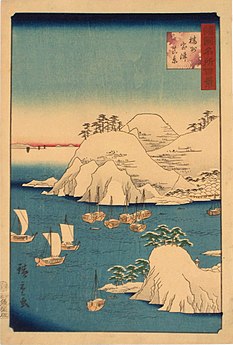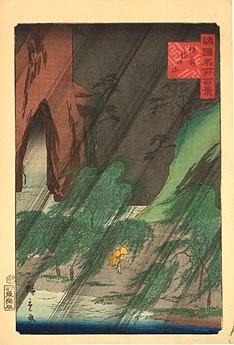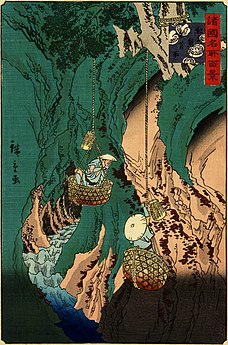
Hiroshige II (二代目 歌川広重, Ni-daime Utagawa Hiroshige, 1826 – 17 September 1869) was a Japanese designer of ukiyo-e art. He inherited the name Hiroshige II following the death in 1858 of his master Hiroshige, whose daughter he married. In 1865 he moved from Edo to Yokohama after dissolving his marriage and began using the name Kisai Risshō (喜斎立祥; alternate pronunciation: Ryūshō). His work so resembles that of his master that scholars have often confused them.
Life and career

Born Suzuki Chinpei (鈴木鎮平) in 1826, it is said that he was born to a fireman, as was his master Hiroshige to whom he became apprenticed under the name Shigenobu at an unknown age. His earliest known work is the illustrations for a book called Twenty-four Paragons of Japan and China from 1849. [1]
Hiroshige II produced a large number of commissioned work in the 1850s in the style of the elder Hiroshige, and often signed his work Ichiryūsai mon ("student of Ichiryūsai", another art name of Hiroshige I's), and from c. 1853 to 1858 simply as Ichiryūsai. In 1858, he married Hiroshige I's daughter Otatsu after the master's death and inherited the Hiroshige name, as well as the names Ichiryūsai and Ryūsai. [1]
The artist moved from Edo to Yokohama in 1865 after dissolving his marriage and began using the name Kisai Risshō (喜斎立祥; alternate pronunciation: Ryūshō). During this decade he produced a number of collaborative print series, particularly with Kunisada, who had earlier worked with Hiroshige I. In his final years he turned mainly to decorating works intended for export, such as tea chests, kites, and lanterns. [1] On 17 September 1869 he died at the age of 44. [1]
Hiroshige I took on few students; Hiroshige II was the most successful of these. His works have often been confounded with those of his master, which they resemble closely in style, subject, and signature. Early Western scholars did not even recognize him as a separate artist. [1]
Another pupil of the first Hiroshige, Shigemasa, later married the master's daughter, Otatsu, and also began using the name Hiroshige; this artist now is known as Hiroshige III. [2]
Galleries
- One Hundred Views of Japan
-
Enshū Akiha Enkei Fukuroi Tako, 1859
-
Hōki Shimodani, 1859
-
Banshū Murotsu, 1859
-
Bizen Tatsunokuchiyama, 1860
-
Chūzenji Lake in Shimozuke Province, 1860
-
Mushroom gathering at Kumano in Kishū, 1860
- Other Works by Hiroshige II
-
Kinryuzan Temple in Asakusa from the series Famous Places in the Eastern Capital, mid-19th century
-
Passage through Hakone from the series Famous Places in Various Provinces, 1850s
-
Steam Engine Railway in Yatsuyama, 1860s
-
Morning Glories in Iriya, Eastern Capital from Thirty-six Selected Flower Scenes, 1866
See also
References
- ^ a b c d e Marks 2012, p. 154.
- ^ Frédéric, Louis (2005). Japan Encyclopedia. Harvard University Press. ISBN 0-674-01753-6.
Works cited
- Marks, Andreas (2012). Japanese Woodblock Prints: Artists, Publishers and Masterworks: 1680–1900. Tuttle Publishing. ISBN 978-1-4629-0599-7.
Further reading
- 'Hiroshige II' in: Forbes, Andrew; Henley, David (2014). 100 Famous Views of Edo. Chiang Mai: Cognoscenti Books. ASIN: B00HR3RHUY
- Lane, Richard. (1978). Images from the Floating World, The Japanese Print. Oxford: Oxford University Press. ISBN 9780192114471; OCLC 5246796
- Newland, Amy Reigle. (2005). Hotei Encyclopedia of Japanese Woodblock Prints. Amsterdam: Hotei. ISBN 9789074822657; OCLC 61666175
External links
Prints
- Catalogue Raisonné of the Work of Utagawa Hiroshige II
- Ukiyo-e Prints by Utagawa Hiroshige II
-
 Media related to
Utagawa Hiroshige II at Wikimedia Commons
Media related to
Utagawa Hiroshige II at Wikimedia Commons










